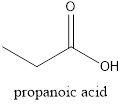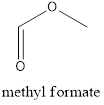
Concept explainers
(a)
Interpretation:
The name and functional group in given molecule needs to be written.
Concept Introduction :
(a)
Answer to Problem 10E
Carboxylic acid
Explanation of Solution
The seven main functional groups are:
- Hydroxyl
- Sulfhydryl
- Carbonyl
- Carboxyl
- Amino and phosphate group
- Alcohols and thiols.
The given compound is as follows:

The name of the given compound is propanoic acid, because it contains a chain of three carbon atom with a function group carboxylic acid and it is a saturated compound.
(b)
Interpretation:
The name and functional group in given molecule needs to be written.
Concept Introduction :
Functional groups are moieties or specific substituents in molecules in organic chemistry, which are accountable for distinguishing chemical reactions of the given molecules.
(b)
Answer to Problem 10E
Explanation of Solution
The seven main functional groups are:
- Hydroxyl
- Sulfhydryl
- Carbonyl
- Carboxyl
- Amino and phosphate group
- Alcohols and thiols.

The name of the given compound is 2-pentanone, because it contains a chain of five carbon atom with a function group ketone and it is a saturated compound.
(c)
Interpretation:
The name and functional group in given molecule needs to be written.
Concept Introduction :
Functional groups are moieties or specific substituents in molecules in organic chemistry, which are accountable for distinguishing chemical reactions of the given molecules.
(c)
Answer to Problem 10E
Ketone
Explanation of Solution
The seven main functional groups are:
- Hydroxyl
- Sulfhydryl
- Carbonyl
- Carboxyl
- Amino and phosphate group
- Alcohols and thiols.

The name of the given compound is 3-methyl-2-butanone, because it contains a straight chain of four carbon atom having a branched methyl group at carbon 3 with a function group ketone and it is a saturated compound.
(d)
Interpretation:
The name and functional group in given molecule needs to be written.
Concept Introduction :
Functional groups are moieties or specific substituents in molecules in organic chemistry, which are accountable for distinguishing chemical reactions of the given molecules.
(d)
Answer to Problem 10E
Ester
Explanation of Solution
The seven main functional groups are:
- Hydroxyl
- Sulfhydryl
- Carbonyl
- Carboxyl
- Amino and phosphate group
- Alcohols and thiols.

The name of the given compound is N-propyl methanoate, because it contains the functional group ester.
(e)
Interpretation:
The name and functional group in each molecule, needs to be written.
Concept Introduction :
Functional groups are moieties or specific substituents in molecules in organic chemistry, which are accountable for distinguishing chemical reactions of the given molecules.
(e)
Answer to Problem 10E
Explanation of Solution
The seven main functional groups are:
- Hydroxyl
- Sulfhydryl
- Carbonyl
- Carboxyl
- Amino and phosphate group
- Alcohols and thiols.

The name of the given compound is N-methylpropan-1-amine, because it contains the functional group amine.
(f)
Interpretation:
The name and functional group in each molecule, needs to be written.
Concept Introduction :
Functional groups are moieties or specific substituents in molecules in organic chemistry, which are accountable for distinguishing chemical reactions of the given molecules.
(f)
Answer to Problem 10E
Ester
Explanation of Solution
The seven main functional groups are:
- Hydroxyl
- Sulfhydryl
- Carbonyl
- Carboxyl
- Amino and phosphate group
- Alcohols and thiols.

The name of the given compound is methyl formate because it contains the functional group ester.
Chapter U2 Solutions
Living by Chemistry
Additional Science Textbook Solutions
Inorganic Chemistry
Chemistry & Chemical Reactivity
Chemistry: An Introduction to General, Organic, and Biological Chemistry (12th Edition) - Standalone book
Chemistry: An Introduction to General, Organic, and Biological Chemistry (13th Edition)
Chemistry: The Central Science (14th Edition)
Chemistry & Chemical Reactivity
 ChemistryChemistryISBN:9781305957404Author:Steven S. Zumdahl, Susan A. Zumdahl, Donald J. DeCostePublisher:Cengage Learning
ChemistryChemistryISBN:9781305957404Author:Steven S. Zumdahl, Susan A. Zumdahl, Donald J. DeCostePublisher:Cengage Learning ChemistryChemistryISBN:9781259911156Author:Raymond Chang Dr., Jason Overby ProfessorPublisher:McGraw-Hill Education
ChemistryChemistryISBN:9781259911156Author:Raymond Chang Dr., Jason Overby ProfessorPublisher:McGraw-Hill Education Principles of Instrumental AnalysisChemistryISBN:9781305577213Author:Douglas A. Skoog, F. James Holler, Stanley R. CrouchPublisher:Cengage Learning
Principles of Instrumental AnalysisChemistryISBN:9781305577213Author:Douglas A. Skoog, F. James Holler, Stanley R. CrouchPublisher:Cengage Learning Organic ChemistryChemistryISBN:9780078021558Author:Janice Gorzynski Smith Dr.Publisher:McGraw-Hill Education
Organic ChemistryChemistryISBN:9780078021558Author:Janice Gorzynski Smith Dr.Publisher:McGraw-Hill Education Chemistry: Principles and ReactionsChemistryISBN:9781305079373Author:William L. Masterton, Cecile N. HurleyPublisher:Cengage Learning
Chemistry: Principles and ReactionsChemistryISBN:9781305079373Author:William L. Masterton, Cecile N. HurleyPublisher:Cengage Learning Elementary Principles of Chemical Processes, Bind...ChemistryISBN:9781118431221Author:Richard M. Felder, Ronald W. Rousseau, Lisa G. BullardPublisher:WILEY
Elementary Principles of Chemical Processes, Bind...ChemistryISBN:9781118431221Author:Richard M. Felder, Ronald W. Rousseau, Lisa G. BullardPublisher:WILEY





